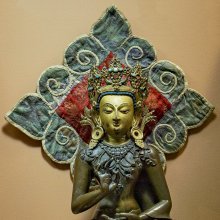Cape, Cāpe, Capé: 2 definitions
Introduction:
Cape means something in biology. If you want to know the exact meaning, history, etymology or English translation of this term then check out the descriptions on this page. Add your comment or reference to a book if you want to contribute to this summary article.
Images (photo gallery)
Biology (plants and animals)
Source: Google Books: CRC World Dictionary (Regional names)Cape in Mexico is the name of a plant defined with Coffea arabica in various botanical sources. This page contains potential references in Ayurveda, modern medicine, and other folk traditions or local practices It has the synonym Coffea arabica var. rotundifolia Ottol. ex Cramer (among others).
Example references for further research on medicinal uses or toxicity (see latin names for full list):
· Mededeelingen uitgeven van het Department van Landbouw in NederlandschIndië (1913)
· Fl. Trop. E. Africa, Rubiaceae (1988)
· Species Plantarum (1753)
If you are looking for specific details regarding Cape, for example pregnancy safety, extract dosage, health benefits, diet and recipes, side effects, chemical composition, have a look at these references.

This sections includes definitions from the five kingdoms of living things: Animals, Plants, Fungi, Protists and Monera. It will include both the official binomial nomenclature (scientific names usually in Latin) as well as regional spellings and variants.
Languages of India and abroad
Kannada-English dictionary
Source: Alar: Kannada-English corpusCāpe (ಚಾಪೆ):—
1) [noun] a flat, coarse fabric made of woven or plaited hemp, straw, rope, etc., used to sit on and occasionally as a screen.
2) [noun] ಚಾಪೆ ಹಾಕು [cape haku] cāpe hāku (fig.) to be courteous or give a warm welcome to a guest. 2. (fig.) to treat a person more preferentially (with favourable bias).
Kannada is a Dravidian language (as opposed to the Indo-European language family) mainly spoken in the southwestern region of India.
See also (Relevant definitions)
Starts with (+49): Cape aloe, Cape ash, Cape blackwood, Cape blue waterlily, Cape broom, Cape bushman grass, Cape bushwillow, Cape coast lily, Cape fig, Cape gardenia, Cape gold, Cape gum, Cape hemp, Cape honey flower, Cape jasmine, Cape jessamine, Cape kafferboom, Cape kweek, Cape laburnum, Cape laurel.
Ends with: Gikucape, Gudicape, Hullucape.
Full-text (+202): Bhushalaka, Kumari, Ashamsa, Kanyakumari, Gudicape, Sangrama, Cape poison onion, Cape leadwort, Cape spinach, Cape raspberry, Cape syringa, Cape blackwood, Cape willow, Cape slangkop, Cape gum, Cape ash, Cape honey flower, Eastern cape cycad, Cape teak, Cape smilax.
Relevant text
Search found 32 books and stories containing Cape, Cāpe, Capé; (plurals include: Capes, Cāpes, Capés). You can also click to the full overview containing English textual excerpts. Below are direct links for the most relevant articles:
Garga Samhita (English) (by Danavir Goswami)
Verse 6.7.12 < [Chapter 7 - The Marriage of Śrī Rukmiṇī]
Chaitanya Bhagavata (by Bhumipati Dāsa)
Verse 3.5.590 < [Chapter 5 - The Pastimes of Nityānanda]
Lord Jhulelal: An Analytical Study (by Thakkar Harish Gopalji)
Part 6 - Respecting Nature < [Chapter 5 - Observations, Discussion and Conclusion]
The Constitutional Crisis in South Africa < [April 1953]
The Constitutional Crisis in South Africa < [April 1953]
Travancore, the Beautiful < [January-February 1935]
Bhesajjakkhandhaka (Chapter on Medicine) (by Hin-tak Sik)
Medicines (f): Gum-Resins (Jatu) < [Chapter 4 - Medicinal Substances in the Chapter on Medicine]
Parables of Rama (by Swami Rama Tirtha)
Story 155 - Ludicrous Fright < [Chapter XXIV - Thought Power]
Related products


